IT disappeared long ago, but in 1972 the Window was still there,
peering through milky cataracts of dust, 35 feet above the floor
of Samuel Goldwyn's old Stage 7. I never would have noticed it if
Richard hadn't suddenly stopped in his tracks as we were taking
a shortcut on our way back from lunch.
"That! was when Sound!
was King!" he said, gesturing dramatically into the upper darknesses
of Stage 7.
It took me a moment,
but I finally saw what he was pointing at: something near the ceiling
that resembled the observation window of a 1930's dirigible, nosing
its way into the stage.Goldwyn Studios, where Richard
Portman and I were working on the mix of "The Godfather,"
had originally been United Artists, built for Mary Pickford when
she founded U.A. with Chaplin, Fairbanks and Griffith in the early
1920's.
By 1972, Stage 7 was
functioning as an attic stuffed with the mysterious lumbering
shapes of disused equipment but it was there that Samuel Goldwyn
produced one 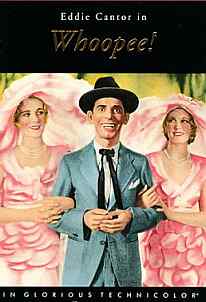 of
the earliest of his many musicals: "Whoopee" (1930), starring Eddie
Cantor and choreographed by Busby Berkeley. And it was there that
Goldwyn's director of sound, Gordon Sawyer, sat at the controls
behind the Window, hands gliding across three Bakelite knobs, piloting
his Dirigible of Sound into a new world . . . a world in which Sound
was King.
of
the earliest of his many musicals: "Whoopee" (1930), starring Eddie
Cantor and choreographed by Busby Berkeley. And it was there that
Goldwyn's director of sound, Gordon Sawyer, sat at the controls
behind the Window, hands gliding across three Bakelite knobs, piloting
his Dirigible of Sound into a new world . . . a world in which Sound
was King.
Down below, Eddie Cantor
and the All-Singing, All- Dancing Goldwyn Girls had lived in terror
of the distinguished Man Behind the Window. And not just the actors:
musicians, cameramen (Gregg Toland among them), the director, the
producer (Florenz Ziegfeld) even Sam Goldwyn himself. No one could
contradict it if Mr. Sawyer, dissatisfied with the quality of the
sound, leaned into his microphone and pronounced dispassionately
but irrevocably the word "Cut!"
By 1972, 45 years after
his exhilarating coronation, King Sound seemed to be living in considerably
reduced circumstances. No longer did the Man Behind the Window survey
the scene from on high. Instead the sound recordist was usually
stuck in some dark corner with his equipment cart. The very idea
of his demanding "Cut!" was inconceivable: not only did none of
them on the set fear his opinion, they hardly consulted him and
were frequently impatient when he did voice an opinion. Forty-five
years seemed to have turned him from king to footman.
Was Richard's nostalgia
misplaced? What had befallen the Window? And were sound's misfortunes
all they appeared to be?
There is something about
the liquidity and all-encompassing embrace of sound that might make
it more accurate to speak of her as a queen rather than a king.
But was she then perhaps a queen for whom the crown was a burden,
and who preferred to slip on a handmaiden's bonnet and scurry incognito
through the back passageways of the palace, accomplishing her tasks
anonymously?
There is a similar mystery
hidden in our own biology: four and a half months after we are conceived,
we are already beginning to hear. It is the first of our senses
to be switched on, and for the next four and a half months sound
reigns as a solitary Queen of the Senses. The close and liquid world
of the womb makes sight and smell impossible, taste and touch a
dim and generalized hint of what is to come. Instead, we luxuriate
in a continuous bath of sounds: the song of our mother's voice,
the swash of her breathing, the piping of her intestines, the timpani
of her heart.
Birth, however, brings
with it the sudden and simultaneous ignition of the other four senses,
and an intense jostling for the throne that Sound had claimed as
hers alone. The most notable pretender is the darting and insistent
Sight, who blithely dubs himself King and ascends the throne as
if it had been standing vacant, waiting for him.
Surprisingly, Sound
pulls a veil of oblivion across her reign and withdraws into the
shadows.
So we all begin as hearing
beings our four and a half month baptism in a sea of sound must
have a profound and everlasting effect on us but from the moment
of birth onward, hearing seems to recede into the background of
our consciousness and function more as an accompaniment to what
we see. Why this should be, rather than the reverse, is a mystery:
why does not the first of our senses to be activated retain a lifelong
dominance of all the others?
Something of this same
situation marks the relationship between what we see and hear in
the cinema. Film sound is rarely appreciated for itself alone but
functions largely as an enhancement of the visuals: by means of
some mysterious perceptual alchemy, whatever virtues sound brings
to film are largely perceived and appreciated by the audience in
visual terms. The better the sound, the better the image.
What in fact had given
film sound its brief reign over the film image was a temporary and
uncharacteristic inflexibility. In those first few years after the
commercialization of film sound, in 1926, everything had to be recorded
simultaneously music, dialogue, sound effects and once recorded,
nothing could be changed. The old Mel Brooks joke about panning
the camera to the left and revealing the orchestra in the middle
of the desert was not far from the truth.
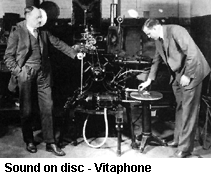 Clem
Portman (Richard's father), Gordon Sawyer, Murray Spivack and the
other founding fathers of film sound had the responsibility for
recording Eddie Cantor's voice, and the orchestra accompanying him,
and his tap dancing all at the same time, in as good a balance as
they could manage. There was no possibility of fixing it later in
the mix, because this was the mix. And there was no possibility
of cutting out the bad bits, because there was no way to cut what
was being chiseled into the whirling acetate of the Vitaphone discs.
It had to be right the first time, or you called "Cut!" and began
again.
Clem
Portman (Richard's father), Gordon Sawyer, Murray Spivack and the
other founding fathers of film sound had the responsibility for
recording Eddie Cantor's voice, and the orchestra accompanying him,
and his tap dancing all at the same time, in as good a balance as
they could manage. There was no possibility of fixing it later in
the mix, because this was the mix. And there was no possibility
of cutting out the bad bits, because there was no way to cut what
was being chiseled into the whirling acetate of the Vitaphone discs.
It had to be right the first time, or you called "Cut!" and began
again.
POWER on a film tends
to gravitate toward those who control a bottleneck of some kind.
Stars wield this kind of power, extras do not; the director of photography
usually has more of it than the production designer. Film sound
in its first few years was one of these bottlenecks, and so the
Man Behind the Window held sway, temporarily, with a kingly power
he has never had since.
The true nature of sound,
though its feminine fluidity and malleability was not revealed
until the perfection of the sprocketed 35-millimeter optical sound
track (1929), which could be edited, rearranged and put in different
synchronous relationships with the image, opening up the bottleneck
created by the inflexible Vitaphone process. This opening was further
enlarged by the discovery of re-recording (1929-30), where several
tracks of sound could be separately controlled and then recombined.
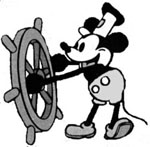 These
developments took some time to work their way into the creative
bloodstream as late as 1936, films were being produced that added
only 17 additional sound effects for the whole film (instead of
the many thousands that we have today). But the possibilities were
richly indicated by the imaginative sound work in Disney's animated
film "Steamboat
Willie" (1928) and de Mille's live-action prison film
"Dynamite" (1929). Certainly they were well established by the time
of Spivack and Portman's ground-breaking work on "King Kong" (1933).
These
developments took some time to work their way into the creative
bloodstream as late as 1936, films were being produced that added
only 17 additional sound effects for the whole film (instead of
the many thousands that we have today). But the possibilities were
richly indicated by the imaginative sound work in Disney's animated
film "Steamboat
Willie" (1928) and de Mille's live-action prison film
"Dynamite" (1929). Certainly they were well established by the time
of Spivack and Portman's ground-breaking work on "King Kong" (1933).
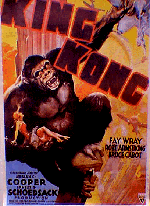 In
fact, animation of both the "Steamboat Willie" and the "King Kong"
varieties has probably played a more significant role in the evolution
of creative sound than has been acknowledged. In the beginning of
the sound era, it was so astonishing to hear people speak and move
and sing and shoot one another in sync that almost any sound was
more than acceptable. But with animated characters this did not
work: they are two-dimensional creatures who make no sound at all
unless the illusion is created through sound out of context: sound
from one reality transposed onto another. The most famous of these
is the thin falsetto that Walt Disney himself gave to Mickey Mouse,
but a close second is the roar that Murray Spivack provided King
Kong.
In
fact, animation of both the "Steamboat Willie" and the "King Kong"
varieties has probably played a more significant role in the evolution
of creative sound than has been acknowledged. In the beginning of
the sound era, it was so astonishing to hear people speak and move
and sing and shoot one another in sync that almost any sound was
more than acceptable. But with animated characters this did not
work: they are two-dimensional creatures who make no sound at all
unless the illusion is created through sound out of context: sound
from one reality transposed onto another. The most famous of these
is the thin falsetto that Walt Disney himself gave to Mickey Mouse,
but a close second is the roar that Murray Spivack provided King
Kong.
There is a symbiotic
relationship between the techniques that we use to represent the
world and the vision that we attempt to represent with those same
techniques: a change in one inevitably results in a change in the
other. The sudden availability of cheap pigments in flexible metal
tubes in the mid-19th century, for instance, allowed the Impressionists
to paint quickly out of doors in fleeting light. And face to face
with nature, they realized that shadows come in many other colors
than shades of gray, which is what the paintings of the previous
"indoor" generations had taught us to see.
Similarly, humble sounds
had always been considered the inevitable (and therefore mostly
ignored) accompaniment of the visual stuck like an insubstantial,
submissive shadow to the object that "caused" them. And like a shadow,
they appeared to be completely explained by reference to the objects
that gave them birth: a metallic clang was always "cast" by the
hammer, just as the village steeple cast its shape upon the ground.
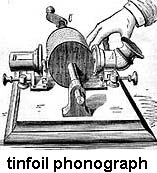 Prior
to Edison's astonishing invention of the phonograph in 1877, it
was impossible to imagine that sound could be captured and played
back later. In fact, sound was often given as the prime example
of the impermanent: a rose that wilted and died as soon as it bloomed.
Prior
to Edison's astonishing invention of the phonograph in 1877, it
was impossible to imagine that sound could be captured and played
back later. In fact, sound was often given as the prime example
of the impermanent: a rose that wilted and died as soon as it bloomed.
Magically, Edison's
discovery loosened the bonds of causality and lifted the shadow
away from the object, standing it on its own and giving it a miraculous
and sometimes frightening autonomy. According to an account in "Ota
Benga," a 1992 book by P. V. Bradford, King Ndombe of the Congo
consented to have his voice recorded in 1904 but immediately regretted
it when the cylinder was played back: the "shadow" danced on its
own, and he heard his people cry in dismay: "The King sits still,
his lips are sealed, while the white man forces his soul to sing!"
The optical film soundtrack
was the equivalent of pigment in a tube, and sound's fluidity the
Impressionist's colored shadow.
Neither Richard Portman
nor I had any inkling, on that afternoon when he showed me the Window,
that the record-breaking success of "The Godfather" several months
later would trigger a revival in the fortunes of the film industry
in general and of sound in particular.
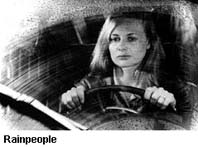 Three
years earlier, in 1969, I had been hired to create the sound effects
for, and mix, "The Rain People," a film written, directed, and produced
by Francis Ford Coppola. He was a recent film school graduate, as
was I, and we were both eager to make films professionally the way
we had made them at school. Francis had felt that the sound on his
previous film ("Finian's Rainbow") had bogged down in the bureaucratic
and technical inertia at the studios, and he didn't want to repeat
the experience.
Three
years earlier, in 1969, I had been hired to create the sound effects
for, and mix, "The Rain People," a film written, directed, and produced
by Francis Ford Coppola. He was a recent film school graduate, as
was I, and we were both eager to make films professionally the way
we had made them at school. Francis had felt that the sound on his
previous film ("Finian's Rainbow") had bogged down in the bureaucratic
and technical inertia at the studios, and he didn't want to repeat
the experience.
He also felt that if
he stayed in Los Angeles he wouldn't be able to produce the inexpensive,
independent films he had in mind. So he and a fellow film student,
George Lucas, and I, and our families, moved up to San Francisco
to start American Zoetrope. The first item on the agenda was the
mix of "The Rain People" in the unfinished basement of an old warehouse
on Folsom Street.
Ten years earlier, this
would have been unthinkable, but the invention of the transistor
had changed things technically and economically to such an extent
that it seemed natural for the 30-year-old Francis to go to Germany
and buy almost off the shelf mixing and editing equipment from
K.E.M. in Hamburg and hire me, a 26-year-old, to use them.
Technically, the equipment
was state of the art, and yet it cost a fourth of what comparable
equipment would have cost five years earlier. This halving of price
and doubling of quality is familiar to everyone now, after 30 years
of microchips, but at the time it was astonishing. The frontier
between professional and consumer electronics began to fade away.
In fact, it faded to
the extent that it now became economically and technically possible
for one person to do what several had done before, and that other
frontier between sound-effects creation and mixing also began
to disappear.
From Zoetrope's beginning,
the idea was to try to avoid the departmentalism that was sometimes
the byproduct of sound's technical complexity, and that tended too
often to set mixers, who came mostly from engineering direct descendants
of the Man Behind the Window against the people who created the
sounds. It was as if there were two directors of photography on
a film, one who lighted the scene and another who photographed it,
and neither could do much about countermanding the other.
We felt that there was
now no reason given the equipment that was becoming available
in 1968 that the person who designed the soundtrack shouldn't
also be able to mix it, and that the director would then be able
to talk to one person, the sound designer, about the sound of the
film the way he was able to talk to the production designer about
the look of the film.
At any rate, it was
against this background that the success of "The Godfather" led
directly to the green-lighting of two Zoetrope productions: George
Lucas's "American Graffiti" and Francis Coppola's "Conversation"
both with very different but equally adventuresome soundtracks,
where we were able to put our ideas to work.
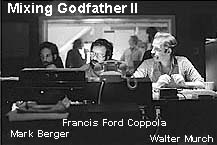 Steven
Spielberg's "Jaws" soon topped the box office of "The Godfather"
and introduced the world at large to the music of John Williams.
The success of "American Graffiti" led to "Star Wars" (with music
by the same John Williams), which in turn topped "Jaws." The 70-millimeter
Dolby release format of "Star Wars" revived and reinvented magnetic
six-track sound and helped Dolby Cinema Sound obtain a crucial foothold
in film post-production and exhibition. The success of the two "Godfather"
films would allow Francis to make "Apocalypse Now," which broke
further ground in originating, at the end of the 1970's, what has
now become the standard film sound format: three channels of sound
behind the screen, left and right surrounds behind the audience,
and low-frequency enhancement.
Steven
Spielberg's "Jaws" soon topped the box office of "The Godfather"
and introduced the world at large to the music of John Williams.
The success of "American Graffiti" led to "Star Wars" (with music
by the same John Williams), which in turn topped "Jaws." The 70-millimeter
Dolby release format of "Star Wars" revived and reinvented magnetic
six-track sound and helped Dolby Cinema Sound obtain a crucial foothold
in film post-production and exhibition. The success of the two "Godfather"
films would allow Francis to make "Apocalypse Now," which broke
further ground in originating, at the end of the 1970's, what has
now become the standard film sound format: three channels of sound
behind the screen, left and right surrounds behind the audience,
and low-frequency enhancement.
Almost all of the technical
advances in sound recording, manipulation and exhibition since 1980
can be summed up in one word: digitization. The effect of digitization
on the techniques and aesthetics of film sound is worth a book in
itself, but it is enough to say at this point that it has continued
forcefully in the direction of earlier techniques to liberate the
shadow of sound and break up bottlenecks whenever they begin to
form.
The Window is long gone,
and will not now return, but the autocratic temporal power that
disappeared with it has been repaid a hundred a thousand times
in creative power: the ability to freely reassociate image and sound
in different contexts and combinations.
This reassociation
of image and sound is the fundamental pillar upon which
the creative use of sound rests, and without which it would collapse.
Sometimes it is done simply for convenience (walking on cornstarch,
for instance, happens to record as a better footstep-in-snow than
snow itself); or for necessity (the window that Gary Cooper broke
in "High Noon" was made not of real glass but of crystallized sheeted
sugar, the boulder that chased Indiana Jones was made not of real
stone but of plastic foam); or for reasons of morality (crushing
a watermelon is ethically preferable to crushing a human head).
In each case, our multi- million-year reflex of thinking of sound
as a submissive causal shadow now works in the filmmaker's favor,
and the audience is disposed to accept, within certain limits, these
new juxtapositions as the truth.
But beyond any practical
consideration, I believe this reassociation should stretch the relationship
of sound to image wherever possible. It should strive to create
a purposeful and fruitful tension between what is on the screen
and what is kindled in the mind of the audience. The danger of present-
day cinema is that it can suffocate its subjects by its very ability
to represent them: it doesn't possess the built-in escape valves
of ambiguity that painting, music, literature, radio drama and black-and-white
silent film automatically have simply by virtue of their sensory
incompleteness an incompleteness that engages the imagination
of the viewer as compensation for what is only evoked by the artist.
BY comparison, film
seems to be "all there" (it isn't, but it seems to be), and thus
the responsibility of filmmakers is to find ways within that completeness
to refrain from achieving it. To that end, the metaphoric use of
sound is one of the most fruitful, flexible and inexpensive means:
by choosing carefully what to eliminate, and then adding back sounds
that seem at first hearing to be somewhat at odds with the accompanying
image, the filmmaker can open up a perceptual vacuum into which
the mind of the audience must inevitably rush.
Every successful reassociation
is a kind of metaphor, and every metaphor is seen momentarily as
a mistake, but then suddenly as a deeper truth about the thing named
and our relationship to it. The greater the stretch between the
"thing" and the "name," the deeper the potential truth.
The tension produced
by the metaphoric distance between sound and image serves somewhat
the same purpose as the perceptual tension generated by the similar
but slightly different images sent by our two eyes to the brain.
The brain, not content with this close duality, adds its own purely
mental version of three-dimensionality to the two flat images, unifying
them into a single image with depth added.
There really is, of
course, a third dimension out there in the world: the depth we perceive
is not a hallucination. But the way we perceive it its particular
flavor is uniquely our own, unique not only to us as a species
but in its finer details unique to each of us individually. And
in that sense it is a kind of hallucination, because the brain does
not alert us to what is actually going on. Instead, the dimensionality
is fused into the image and made to seem as if it is coming from
"out there" rather than "in here."
In much the same way,
the mental effort of fusing image and sound in a film produces a
"dimensionality" that the mind projects back onto the image as if
it had come from the image in the first place. The result is that
we actually see something on the screen that exists only in our
mind and is, in its finer details, unique to each member of the
audience. We do not see and hear a film, we hear/see it.
This metaphoric distance
between the images of a film and the accompanying sounds is and
should be continuously changing and flexible, and it often takes
a fraction of a second (sometimes even several seconds) for the
brain to make the right connections. The image of a light being
turned on, for instance, accompanied by a simple click: this basic
association is fused almost instantly and produces a relatively
flat mental image.
Still fairly flat, but
a level up in dimensionality: the image of a door closing accompanied
by the right "slam" can indicate not only the material of the door
and the space around it but also the emotional state of the person
closing it. The sound for the door at the end of "The Godfather,"
for instance, needed to give the audience more than the correct
physical cues about the door; it was even more important to get
a firm, irrevocable closure that resonated with and underscored
Michael's final line: "Never ask me about my business, Kay."
That door sound was
related to a specific image, and as a result it was "fused" by the
audience fairly quickly. Sounds, however, that do not relate to
the visuals in a direct way function at an even higher level of
dimensionality, and take proportionately longer to resolve. The
rumbling and piercing metallic scream just before Michael Corleone
kills Solozzo and McCluskey in a restaurant in "The Godfather" is
not linked directly to anything seen on screen, and so the audience
is made to wonder at least momentarily, if perhaps only subconsciously,
"What is this?" The screech is from an elevated train rounding a
sharp turn, so it is presumably coming from somewhere in the neighborhood
(the scene takes place in the Bronx).
But precisely because
it is so detached from the image, the metallic scream works as a
clue to the state of Michael's mind at the moment the critical
moment before he commits his first murder and his life turns an
irrevocable corner. It is all the more effective because Michael's
face appears so calm and the sound is played so abnormally loud.
This broadening tension between what we see and what we hear is
brought to an abrupt end with the pistol shots that kill Solozzo
and McCluskey: the distance between what we see and what we hear
is suddenly collapsed at the moment that Michael's destiny is fixed.
THIS moment is mirrored
and inverted at the end of "Godfather III." Instead of a calm face
with a scream, we see a screaming face in silence. When Michael
realizes that his daughter Mary has been shot, he tries several
times to scream but no sound comes out. In fact, Al Pacino was
actually screaming, but the sound was removed in the editing. We
are dealing here with an absence of sound, yet a fertile tension
is created between what we see and what we would expect to hear,
given the image. Finally, the scream bursts through, the tension
is released, and the film and the trilogy is over.
The elevated train in
"The Godfather" was at least somewhere in the vicinity of the restaurant,
even though it could not be seen. In the opening reel of "Apocalypse
Now," the jungle sounds that fill Willard's hotel room come from
nowhere on screen or in the "neighborhood," and the only way to
resolve the great disparity between what we are seeing and hearing
is to imagine that these sounds are in Willard's mind: that his
body is in a hotel room in Saigon, but his mind is off in the jungle,
where he dreams of returning. If the audience members can be brought
to a point where they will bridge with their own imagination such
an extreme distance between picture and sound, they will be rewarded
with a correspondingly greater dimensionality of experience.
The risk, of course,
is that the conceptual thread that connects image and sound can
be stretched too far, and the dimensionality will collapse: the
moment of greatest dimension is always the moment of greatest tension.
The question remains,
in all of this, why we generally perceive the product of the fusion
of image and sound in terms of the image. Why does sound usually
enhance the image, and not the other way around? In other words,
why does King Sight still sit on his throne and Queen Sound haunt
the corridors of the palace?
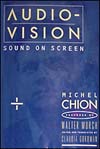 In
his book "AudioVision",
Michel Chion describes an effect that he calls the acousmêtre,
which depends on delaying the fusion of sound and image to the extreme
by supplying only the sound most frequently a voice and withholding
the revelation of the sound's true source until nearly the end of
the film. Only then, when the audience has used its imagination
to the fullest, is the identity of the source revealed. The Wizard
in "The Wizard of Oz" is one of a number of examples, along with
the mother in "Psycho" and Hal in "2001" (and although he didn't
mention it, Wolfman Jack in "American Graffiti" and Colonel Kurtz
in "Apocalypse Now"). The acousmκtre is for various reasons having
to do with our perceptions a uniquely cinematic device: the disembodied
voice seems to come from everywhere and therefore to have no clearly
defined limits to its power. And yet . . .
In
his book "AudioVision",
Michel Chion describes an effect that he calls the acousmêtre,
which depends on delaying the fusion of sound and image to the extreme
by supplying only the sound most frequently a voice and withholding
the revelation of the sound's true source until nearly the end of
the film. Only then, when the audience has used its imagination
to the fullest, is the identity of the source revealed. The Wizard
in "The Wizard of Oz" is one of a number of examples, along with
the mother in "Psycho" and Hal in "2001" (and although he didn't
mention it, Wolfman Jack in "American Graffiti" and Colonel Kurtz
in "Apocalypse Now"). The acousmκtre is for various reasons having
to do with our perceptions a uniquely cinematic device: the disembodied
voice seems to come from everywhere and therefore to have no clearly
defined limits to its power. And yet . . .
And yet there is an
echo here of our earliest experience of the world: the revelation
at birth that the song that sang to us from the very dawn of our
consciousness in the womb a song that seemed to come from everywhere
and to be part of us before we had any conception of what "us" meant
that this song is the voice of another and that she is now separate
from us and we from her. We regret the loss of former unity some
say that our lives are a ceaseless quest to retrieve it and yet
we delight in seeing the face of our mother: the one is the price
to be paid for the other.
This earliest, most
powerful fusion of sound and image sets the tone for all that are
to come.